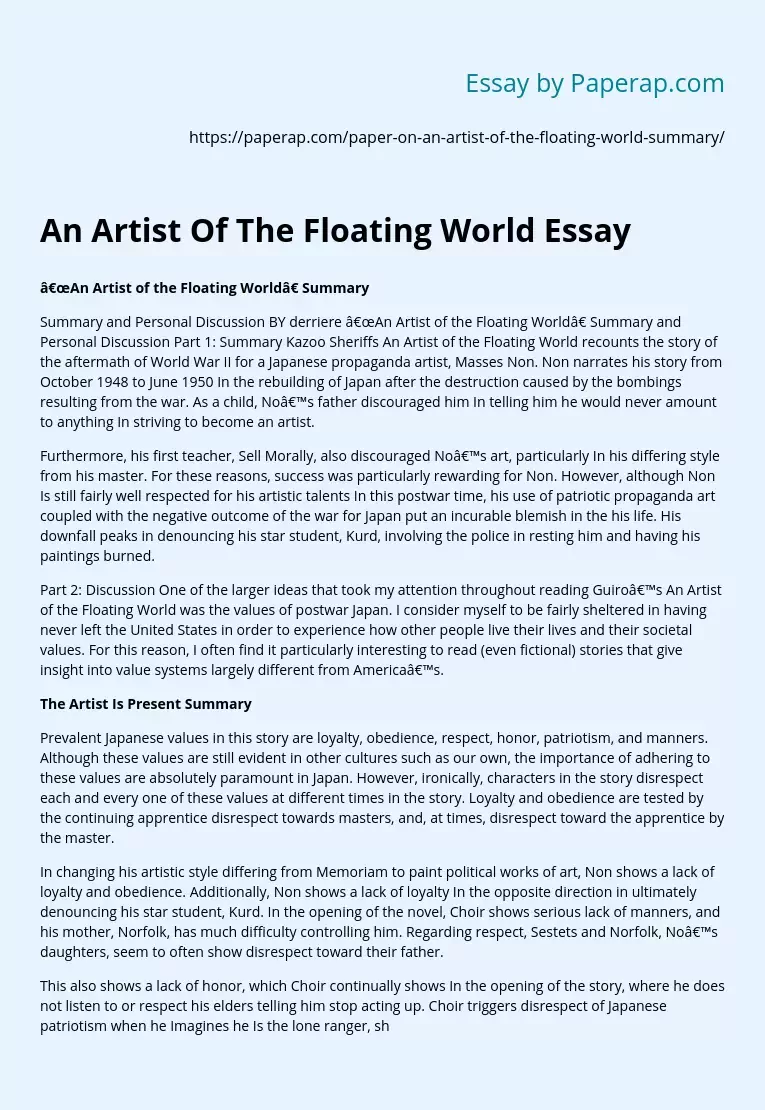An Artist Of The Floating World Essay
“An Artist of the Floating World” Summary
Summary and Personal Discussion BY derriere “An Artist of the Floating World” Summary and Personal Discussion Part 1: Summary Kazoo Sheriffs An Artist of the Floating World recounts the story of the aftermath of World War II for a Japanese propaganda artist, Masses Non. Non narrates his story from October 1948 to June 1950 In the rebuilding of Japan after the destruction caused by the bombings resulting from the war. As a child, No’s father discouraged him In telling him he would never amount to anything In striving to become an artist.
Furthermore, his first teacher, Sell Morally, also discouraged No’s art, particularly In his differing style from his master. For these reasons, success was particularly rewarding for Non. However, although Non Is still fairly well respected for his artistic talents In this postwar time, his use of patriotic propaganda art coupled with the negative outcome of the war for Japan put an incurable blemish in the his life.
His downfall peaks in denouncing his star student, Kurd, involving the police in resting him and having his paintings burned.
Part 2: Discussion One of the larger ideas that took my attention throughout reading Guiro’s An Artist of the Floating World was the values of postwar Japan. I consider myself to be fairly sheltered in having never left the United States in order to experience how other people live their lives and their societal values. For this reason, I often find it particularly interesting to read (even fictional) stories that give insight into value systems largely different from America’s.
The Artist Is Present Summary
Prevalent Japanese values in this story are loyalty, obedience, respect, honor, patriotism, and manners. Although these values are still evident in other cultures such as our own, the importance of adhering to these values are absolutely paramount in Japan. However, ironically, characters in the story disrespect each and every one of these values at different times in the story. Loyalty and obedience are tested by the continuing apprentice disrespect towards masters, and, at times, disrespect toward the apprentice by the master.
In changing his artistic style differing from Memoriam to paint political works of art, Non shows a lack of loyalty and obedience. Additionally, Non shows a lack of loyalty In the opposite direction in ultimately denouncing his star student, Kurd. In the opening of the novel, Choir shows serious lack of manners, and his mother, Norfolk, has much difficulty controlling him. Regarding respect, Sestets and Norfolk, No’s daughters, seem to often show disrespect toward their father.
This also shows a lack of honor, which Choir continually shows In the opening of the story, where he does not listen to or respect his elders telling him stop acting up. Choir triggers disrespect of Japanese patriotism when he Imagines he Is the lone ranger, showing his proclivity for American culture. Although Non shows that he Is uncomfortable with this behavior, the elders allow Choir to continue. In An Artist of the Floating World. Ginsburg snows ten Importance AT several values In ten Japanese culture.
Ginsburg manages to portray the difference in the cultural emphasis of certain virtues in Japan ND America while the characters still constantly disrespected these values as Americans characteristically do. I found this to be a fairly skilled interpretation by the author in showing the importance of these values for the Japanese culture but not for the specific Japanese characters in the story. The extra utility of the main character as a narrator in the story (providing the story but also a point of view on the story) allows for these conflicting ideals to be portrayed clearly to the reader.
An Artist Of The Floating World Essay. (2019, Dec 05). Retrieved from https://paperap.com/paper-on-an-artist-of-the-floating-world-summary/

